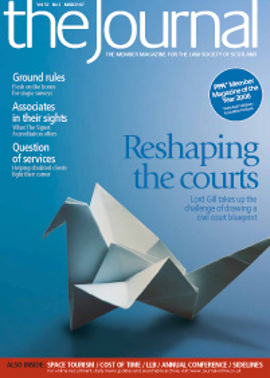Squaring the circle

Whatever the outcome of the Scottish Parliament elections in May, no one can accuse the present Executive of taking its foot off the pedal as the current session draws to a close. The appointment last month of Lord Gill, the Lord Justice Clerk, to head a thoroughgoing review of the structure, jurisdiction, procedures and working methods of the civil courts in Scotland, signals an intention to leave a lasting legacy whoever may be presented with the resulting policy choices.
Currently expected to take around two years to complete its inquiry, at the time of writing neither the membership of the review group nor its detailed terms of reference had been confirmed. However a report published with the announcement of the review, Modern Laws for a Modern Scotland, confirms that the Executive has taken up the challenge presented by Lord Coulsfield’s advisory group in its November 2005 report.
Four out of six
Readers may recall (see Journal, December 2005, cover feature) that the latter report, commissioned by the Scottish Consumer Council with support from the Nuffield Foundation, identified six key features of the present civil justice system that called for urgent review if the system was to be rendered capable of meeting public needs and expectations:
- the disproportionate cost of litigation, especially in lower-value cases;
- disruption due to criminal cases being given priority in the court system;
- the potential benefits from increased specialisation by courts and judges;
- an increased case management role for the courts;
- payment arrangements for lawyers, including fixed fees; and
- increased powers to ensure observance of judgments.
The first four of these have been identified by the Executive as the most urgent and as the basis for Lord Gill’s inquiry. With legal fees, the Executive sees its role as essentially limited to questions of public funding; and reform of diligence was undertaken in the Bankruptcy and Diligence etc (Scotland) Act 2007.
Modern Laws also cautions against too broad-ranging a remit, with the risk of the review “becoming unwieldy to manage and unfocused in its work”. Clear parameters within which the review is to work, and clear objectives which can be fulfilled within a reasonable time, are the aim.
Twin track approach
Two key principles underpin the Executive’s goals: proportionality, and value for money. The first of these requires “systems and processes that are proportionate to the importance, complexity and monetary value of the issues involved”; the second, “making sure civil justice services are efficient, meet reasonable public expectations, and promote early resolution of disputes”.
One suspects that Lord Coulsfield’s group would have put a little more emphasis on user friendliness and public confidence. Their report noted with concern research findings suggesting that even among those people not deterred by the formality and cost from using court proceedings, and even where successful in court, there exists more dissatisfaction with the system than in England and Wales; it quoted a paper prepared for the group which suggested that trial by court had become the new “trial by ordeal”. And after noting that most people involved in disputes are more interested in finding a resolution to their problem, or obtaining compensation, than necessarily enforcing their legal rights, Coulsfield suggests that in the 21st century, “there is a need for an increased emphasis on ‘problem solving’ in the civil justice system, rather than focusing as in the past on the formal declaration of legal rights”.
Both reports, however, are at one in seeking resolution of disputes at as early a stage as possible.
Priorities for action
To the Executive, proportionality involves giving the court itself a role in deciding how a case should be initiated and presented, and how much of the court’s time and other resources it should receive. Giving a clear pointer to Lord Gill’s team, the Modern Laws report continues: “The review will have the task of identifying how best to reform court processes so that our judges have the tools to ensure that cases are dealt with in ways which are proportionate to their monetary value and the importance and complexity of the issues raised.”
Developing value for money indicators, it recognises, will be “a complex task, involving considering what are desirable outcomes and reasonable expectations”. While not losing sight of other values, such as treating people fairly and with respect, and being accessible, the Executive wants to be able to assess and compare the extent to which different types of service within the justice system provide value and efficiency, in terms both of monetary cost and of meeting public expectations. Particularly in this context, Modern Laws emphasises the desirability of promoting early resolution of disputes, preferably without recourse to the courts.
Undercurrents
How far a new approach requires a change in thinking on the part of the legal profession is a key question, as the Coulsfield report recognises. Lord Coulsfield accepts that many lawyers say they will attempt to negotiate a settlement before moving towards court proceedings, but points out that this is often against the background, i.e. threat, of legal proceedings, and that there is some evidence of a continuing lack of enthusiasm about mediation as an alternative. A similar ambivalence towards mediation can be found in the judiciary.
A fundamental issue, his group’s report continues, is who pays for dispute resolution services. “The central question to be addressed is to what extent the state should be responsible for providing a menu of choices, and what should be left to the private market.” This leads on to a discussion of the role of court-annexed mediation schemes, and with it case management by judges, pre-action protocols, early neutral evaluation (an opinion by a third party as to the likely outcome, used as a basis for settlement discussions), and other matters. All of these options are likely to come under scrutiny by Lord Gill in his search for improvements to the present system.
For those cases that continue to require formal resolution, recent contributors to the Journal have argued persuasively for more tribunals (in the widest sense) dedicated to particular types of case. For example Mike Dailly of Govan Law Centre (Journal, August 2005, 9) proposed that the large numbers of debt actions and domestic landlord-tenant disputes should each have a body able to concentrate exclusively on such cases (in the latter instance, covering the social housing as well as the private rented sector). Family lawyer Jenny Nobbs (Journal, October 2006, 26) called for the Glasgow family court model to be followed in other parts of Scotland. And only last month (Journal, February 2007, 16) Sheriff Principal Edward Bowen QC followed this up by proposing some much further-reaching reforms, including a complete split of the civil and criminal sheriff courts – something else Lord Gill may be expected to take a closer look at.
Can Lord Gill achieve for civil justice what Lord Bonomy did for the High Court? With a far more complex task ahead of him, comparisons are probably unfair. It will give him a head start that at the very least there are those at all levels in the profession who accept the case for radical change. Perhaps they are a majority. It is unlikely that they all hold similar views as to the desired outcome; but that only makes it the more important that over the next two years we see the highest quality of debate on the issues at stake.
The Journal welcomes further contributions on the future of civil justice in Scotland.
To discuss a possible submission, contact the editor (t: 0141 560 3018;
e: peter@connectcommunications.co.uk)
EXECUTIVE REVISITS JUDICIAL INDEPENDENCE
The Scottish Executive has published a second consultation paper on judicial independence and the administration of Scotland’s courts, with a draft Judiciary (Scotland) Bill.
Last year the paper “Strengthening Judicial Independence in a Modern Scotland” caused significant protest from judges and others, who feared that aspects of the proposals would in fact increase Executive influence over the judiciary (see Gilmour, Journal, June 2006, 16). It was also suggested that placing the Lord President at the head of a unified judiciary would place too heavy a burden on the holder of the office.
Some modifications have been made to the proposals. Sheriffs are no longer to be subject to transfer at the direction of a minister, but by the Lord President. The Lord President would still become the head of a unified judiciary, with powers and responsibilities for training, welfare, deployment and conduct, and for the management of business in the courts, as well as for overseeing a complaints procedure – another matter that caused adverse comment.
However the paper states that it would be premature to do more than set out what appear to be the main areas requiring legislation, and the draft bill contains no provisions on this topic.
Other proposed measures include: a statutory guarantee of judicial independence; a statutory footing for the Judicial Appointments Board; an appointment panel to recommend candidates for the offices of Lord President and Lord Justice Clerk; provision for the functions of these judges to be carried out during their incapacity, suspension from office or when the office is vacant; and new arrangements for removing judges and sheriffs on grounds of unfitness.
Justice Minister Cathy Jamieson said: “Only once we have reached decisions on the Lord President’s governance role, can we take a firm view on the legislation required to address the many practical issues that would flow from it.
“We will take account of all subsequent responses while finalising the draft bill which we plan to have ready for any new administration to introduce into the Scottish Parliament.”
The Law Society of Scotland supports a specific proposal for eligibility for appointment as a judge to be widened to include solicitor advocates with five years’ experience of either criminal or civil rights of audience, as opposed to holding both qualifications as at present.
Comments on the paper, which can be viewed at www.scotland.gov.uk/Publications/2007/02/13115213/0, are invited by 30 April 2007.
(First reported on www.journalonline.co.uk)
In this issue
- A look in the mirror
- A welcome review
- Squaring the circle
- Profitability and financial structure
- Access-ability
- Culture change
- Practice? What practice?
- Signet badge takes wing
- Four in one
- Appreciation: Angus McLean
- In on the Acts
- "Lossiemouth, we have a problem"?
- Flagging up VAT
- In the family way
- Practice inside out
- Shape of things to come
- Breaking down a brick wall?
- Playing by the rules
- Scottish Solicitors' Discipline Tribunal
- Website reviews
- Book reviews
- Funny thing
- PIPs' hour approaches
- Enabled in the housing market
- Registers refresher






